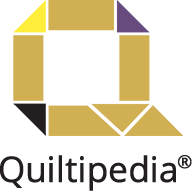Free Motion Quilting
Free Motion Quilting is machine qulting the quilt top, batting and backing without the aid of the machine's feed-dogs to move the quilt sandwich forward. The size of the stitches are based on the speed of the machine and the quilter's hand movements, not controlled by the machine as in regular machine sewing with the feed-dogs. The quilting can be based on a stencil or pre-drawn line or free-hand without a drawn pattern.
Benefits of Free Motion Quilting
Elaborate designs can be quilted with Free Motion Quilting. As the quilt can be moved in all directions, side to side and front to back without having to be turned, curving designs are possible.
Free Motion Quilting can be faster than quilting with the feed-dogs engaged. The quilter can move over the surface of the quilt without having to follow a line, like in "stitch in the ditch" or straight line grid quilting.
Free Motion Quilting adds beauty to quilts and allows the maker to finish quilt tops much faster than hand quilting.
Supplies and Tools for Free Motion Quilting
- Sewing Machine- Free Motion Quilting can be achieved with almost any domestic machine, however, today's machines with wider harp space can be helpful. The more space available between the needle and the right side of the machine, the easier it is to handle the quilt under the needle.
- Free Motion Quilting Presser Foot or "hopping feet"- the foot is designed to "hop" or lift up to enable moving the fabric. Choose a foot that provides the greatest amount of visibility to the quilt surface.
- Quilting Gloves or Grippers- Many quilters like to use something on their hands to provide gripping power when moving a large quilt under the needle. Specialty gloves are available, such as Machingers, Quilter's Gloves, and GrabARoos or clean, new garden or kitchen gloves can be used. Other gripping tools include Grip-Its, Quilt Halo, Quilting Gripper Rings and other tools that sit on top of the quilt sandwich and allow the quilter to move the quilt under the needle by pressing down on the tool.
- Time- There is a learning curve to Free Motion Quilting so tools include videos and books on the subject. It takes practice, practice and more practice.
- Practice Quilt Sandwiches - use leftover fabric and batting to create practice quilt sandwiches and practice your favorite free motion quilting patterns. This will also allow you to mark the practice piece for borders, corners and blocks.
What I Wished I Knew When I Started Free Motion Quilting
Practice really does make one better at this skill. Most quilters are not happy with their first attempts at Free Motion Quilting. Stick with it and you will see improvement. Practice by drawing the design, over and over; then quilt the design in the same place...over and over. You also don't have to learn every design there is- start simple, pick a few that you really like and concentrate on getting good at those.









